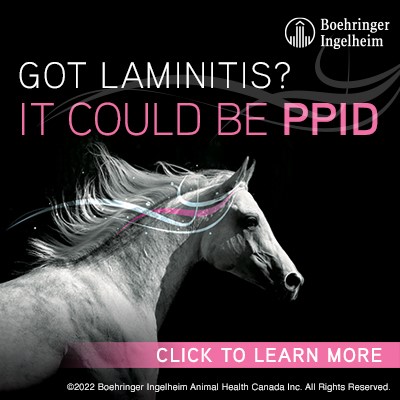Top Health Concerns for Senior Horses
Like humans, horses are living longer than ever. Typically, older horses will live into their 20’s and often times, their 30’s!

It’s natural to worry about your horse’s health into the golden years. Studies report that 70% of horses 20 years or older have some type of health issue requiring modifications in management practices and veterinary care. Let’s examine the key six issues your older horse might face – as well as tips to help you keep your horse feeling comfortable during those senior years.
TIP: Similar to people growing old, it’s important to balance vigilance while appreciating the natural processes of aging in senior horses.
1. Dental Concerns
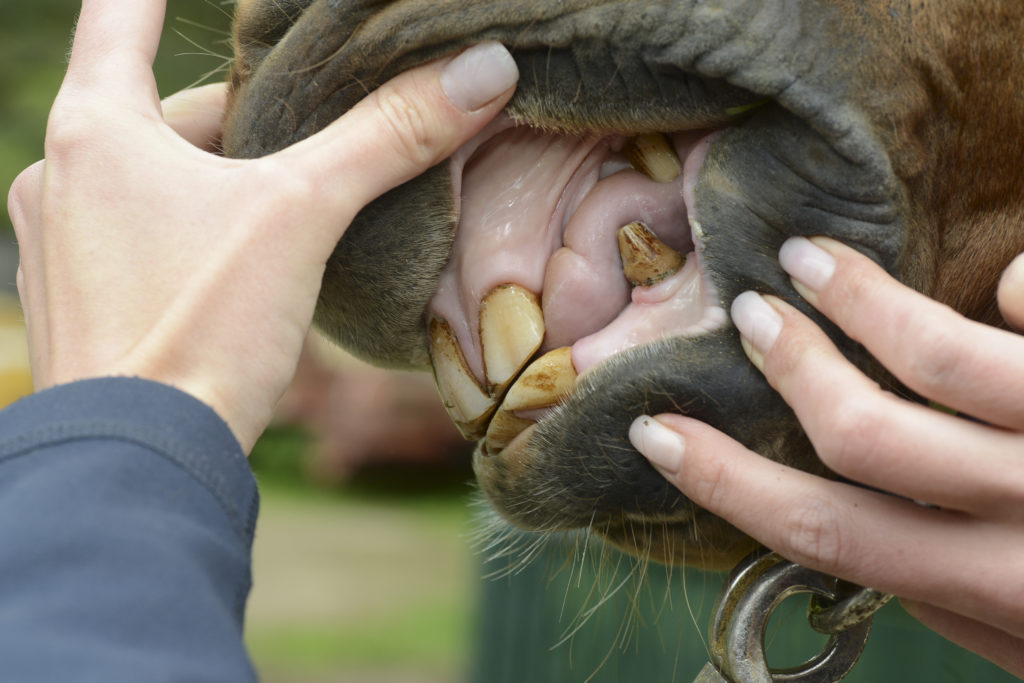
One of the most common health issues of senior horses is dental disease. Extra diligence needs to be paid to the health of teeth in the senior horse. Horses’ front teeth continually erupt at an angle that increases as they age. Cases of unbalanced chewing surfaces escalate as the horse ages. Horses wear down their teeth as they chew but that wear is not always even. The development of sharp points in the mouth is much higher in the elderly equine and this can result in ulcerations, reluctance to chew their food, poor digestion and a higher incidence of choke.
Severely uneven wear can lead to a condition called ‘wave mouth’. Missing or loose teeth can lead to ‘step mouth’ which requires regular inspection and care as food can get packed in leading to dental disease, abscess or infection. In very elderly horses, the teeth may lose their rough edges and become entirely smooth which results in an inability to grind food.
Maintaining good dental health into old age is probably one of the single best ways to encourage longevity. It is far more difficult to address and fix a chronic dental issue once the horse has reached an older age.
TEETH TIPS
- If you notice your horse is no longer chewing in a regular circular pattern, this can be an indicator of sharp points and uneven wear – and warrants a vet appointment for dental care.
- Horses with smooth mouth should be fed highly digestible feeds that are easy to eat, such as soaked hay cubes or beet pulp; your veterinarian or equine nutritionist will be able to recommend the best course of management.
- Foul odors coming from the mouth, difficulty chewing, dropping food, nasal discharge, loose incisors, broken teeth, red or inflamed gums, quidding, weight loss, not finishing feed, grain in manure and resistance to the bridle are all reasons to call the vet for a dental check-up.
2. Joint Health (Arthritis)
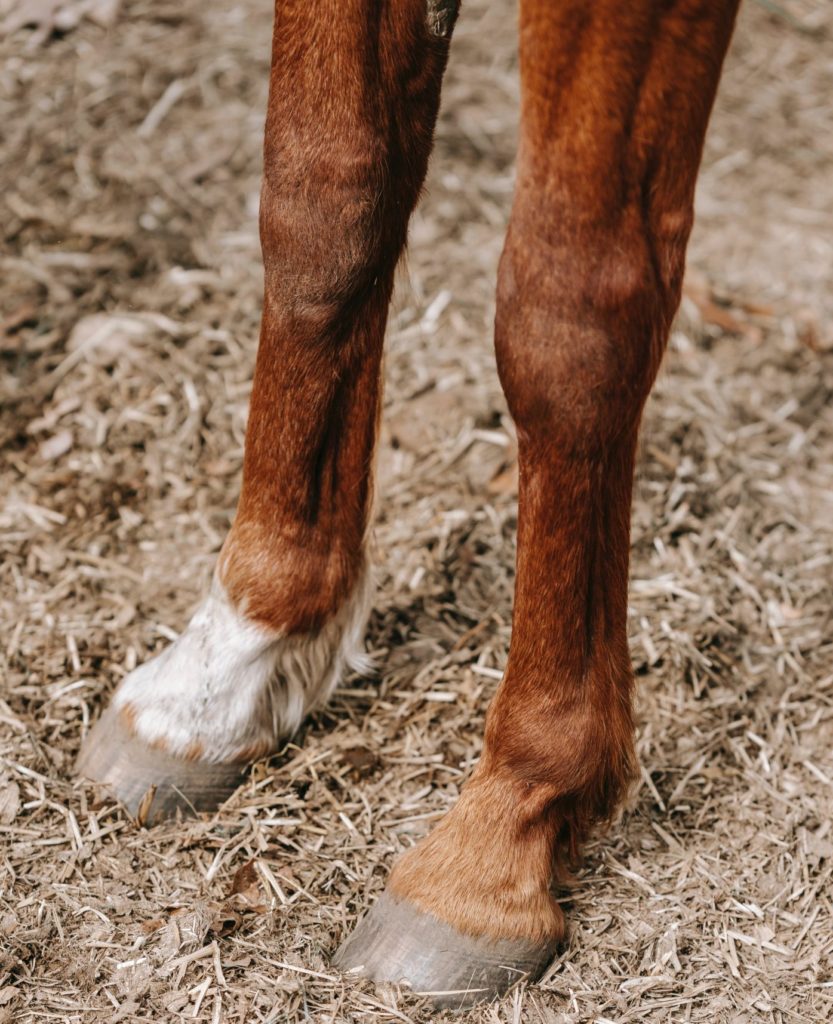
60% of all equine lameness is due to arthritis. Arthritis can be caused by injury, but most often in the senior horse, it is the result of simple wear and tear over the decades.
Common causes are:
- Every day wear and tear – Repetitive and excessive force on a joint may cause inflammation and break down the lubricating synovial fluid, damaging the supporting tissues of the joints. All of this, in turn, triggers more inflammation, and the cycle continues, leading to chronic arthritis.
- Physical Injury – Triggers inflammation.
- Weight-bearing joints – Knee, hock, fetlock, pastern and coffin joints are more prone to be arthritic since they endure the majority of the concussive forces. Maintaining correct hoof balance is important as a poorly balanced hoof can further overload joints.
- Poor conformation – May cause abnormal forces, placing additional strain on joints.
- Other injury – bacterial infection (septic arthritis) and joint fractures will stimulate an inflammatory response that damages the joint surfaces.
JOINT TIPS
- Keep your horse moving. Slow and moderate exercise – even as simple as pasture turn-out – helps to keep joints lubricated and stiffness at bay.
- Consider a joint-support supplement for your senior horse. Consult with your veterinarian on recommendations that combine active ingredients that will be most beneficial for your horse.
- Talk to your veterinarian about nonsteroidal anti-inflammatory drugs (e.g. firocoxib) to help control routine arthritis pain in your aging equid.
j
3. Nutrition/Weight/Gut Issues
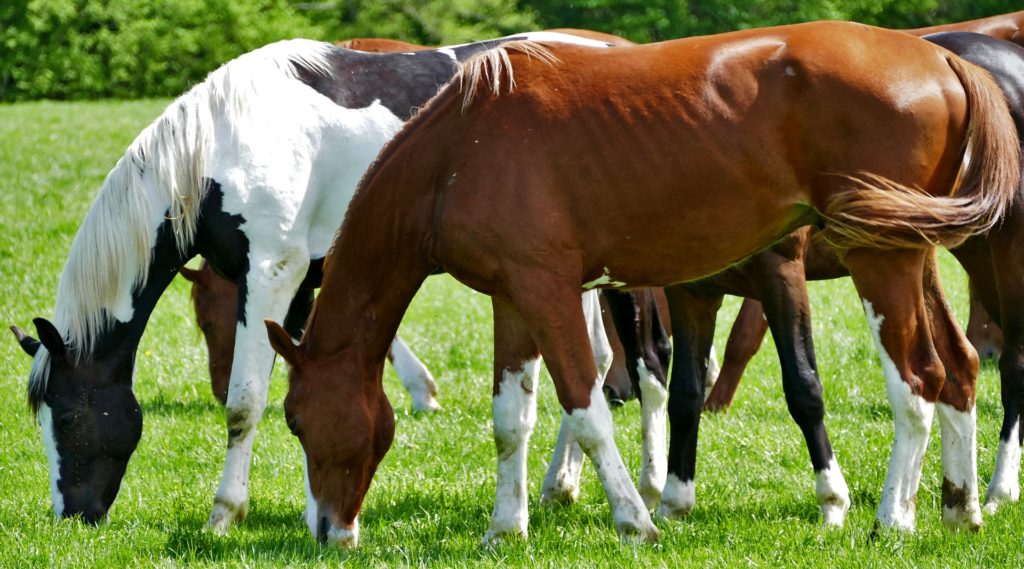
Horses, as they grow old, may drop a few pounds; this can be caused by a number of reasons. One needs to rule out factors which can cause weight loss such as parasite burden, tumors and infections. Winters can begin to take a tougher toll on the senior horse. The energy required for a horse to thermoregulate in the cold is often underestimated. This may require an increase in feed and a blanket to help stay warm. Old age is no excuse for an overly thin equine; an older horse’s body condition score should be between four and seven. Discuss with your veterinarian or equine nutritionist the best methods to satisfy your senior’s dietary needs.
The risk of Colic increases in senior horses. Gut motility issues are more common in older horses, which can lead to an increased risk of impaction colic. Other issues in the senior gastro-intestinal tract which elevate the risk of colic can include tumors or increased parasite load. Older horses tend to have a reduced drive to drink and inadequate intake of water is also a risk factor. Difficulty in chewing feed can result in undigested food entering the gut which can also lead to gas or impaction colic. Digestion is impaired if a horse is unable to grind food properly.
NUTRITION TIPS
- Investigate a senior feed – palatable, easy to chew, high in fat and calorie-dense.
- If extra calories are still required, consider a fat-based weight-gain supplement to feed.
- Beware of overfeeding!
- Body condition scoring should be the weekly routine for every senior horse – the use of a weight tape is also a helpful tool in tracking weight.
- If a change in feed is required due to difficulty in chewing, be sure to make these changes slowly to allow gut bacteria and enzymes a chance to adapt.
- 1.5-2.5% of body weight (on a dry matter basis) of a good quality forage should be enough to keep your senior in good condition. Provide free access to water, salt (loose preferred) and a forage balancer.
4. Diseases & Metabolic Conditions

As horses age, they become more susceptible to illness and disease. Below are three diseases and metabolic conditions common to aging horses:
- PPID/Cushings
- Laminitis
- EMS
PPID (Pituitary pars intermedia dysfunction or Cushing’s Disease)
PPID, commonly referred to as Cushing’s disease, is a common problem in senior horses. Caused by an over-active pituitary gland, this endocrine disease is seen mainly in horses with an average age of 20 years, but has been diagnosed in horses and ponies as young as 10. While all ages, genders and breeds are susceptible to developing PPID, ponies and some breeds of horses (specifically Latin blooded horses such as Paso Finos, Peruvian Pasos, Spanish Mustangs, Arabs and Morgans) seem to develop PPID more frequently.
Common signs and symptoms of PPID in an old horse include:
- Long and curly coat (that does not shed in the summer), patches of long hair on the legs, changes in coat colour, unusual whisker growth
- Pot-belly appearance
- Loss of muscle
- Fat deposits on top of the neck, tail, head and around eyes
- Excessive drinking, sweating and urinating
- Persistent skin infections
- Hoof abscesses
Up to 70% of horses seen for laminitis have been found to have PPID. It is often treated without identifying the underlying cause.
Early diagnosis is important. If you notice any of the above signs in your older horse – contact your veterinarian. Currently there is no cure for PPID but there are ways to help control the signs and improve health of the horse by working closely with your veterinarian.
Laminitis
While laminitis can occur in horses of any age, the disease is a bigger issue in older horses when they develop other diseases that put them at a higher risk for this debilitating hoof disease.
Laminitis is the inflammation of the soft tissues in the hoof. As a result of the inflammation and associated damage to the laminae, the coffin bone of a senior horse’s hoof separates and the pedal bone rotates – pressing on the sole of the hoof and causing extreme pain. Horses with Laminitis often stand with their front feet well out in front of them, rocking back on their heels to seek relief from the pain. They can appear as if they are ‘walking on eggshells’. In severe cases, it is so painful that it affects the inability to walk, leading to weight loss and poor quality of life – sometimes ending in euthanasia.
Laminitis has many different causes and is not limited to the horse or pony which eats an overabundance of rich grass (often when given unrestricted access to rich spring pastures). It can develop from: eating poisonous plants, overconsumption of grain, chronic obesity, retaining the placenta after foaling, a disease that spikes a prolonged high temperature or trauma from repeated concussive forces (road founder).
Laminitis can occur at any age however, overweight horses and those with metabolic syndromes (more frequent in older horses) do have a higher risk of laminitis. Senior horses with Cushing’s disease are at risk to develop secondary laminitis as well.
Stall rest, cold therapy, corrective shoeing, pain management and anti-inflammatory therapy are some of the many treatments that your veterinarian may use to try and treat laminitis. The severity of the laminitis, and the length of time it persists will be factors in determining how soon, or if the horse will be able to return to its previous level of activity.
The first step in preventing recurring laminitis is to find the cause. Managing laminitis requires a plan with both veterinarian and farrier working together with regular assessments.
EMS (Equine Metabolic Syndrome)
Equine Metabolic Syndrome (EMS) is an endocrine/metabolic condition similar to Type 2 diabetes in humans. The condition affects the horse in three ways: 1. obesity and/or fat deposits, 2. insulin resistance (produce too much insulin) and 3. a predisposition to laminitis.
EMS is a result of genetics in combination with other factors, i.e.: inactivity, obesity, high sugar diets and simultaneous illnesses. “Easy keeper” is a term often associated with horses and ponies that have EMS, prone to become overweight.
The breeds that appear to be most commonly affected include donkeys, ponies, Arabians, Morgans, Saddlebreds, Paso Finos, Spanish Mustangs, and Warmbloods. Thoroughbreds and Standardbreds infrequently suffer from EMS.
It is important to watch for signs of EMS in your “easy keeper”: obesity, difficulty losing weight, ease of weight gain, development of fatty deposits (particularly in the crest of the neck), development of laminitis and increased inflammatory responses.
There is a fair bit of confusion in the horse world over mixing up PPID and EMS as they share many of the same clinical signs. Horses with PPID may also have some of the features of EMS but horses with EMS only rarely have PPID.
Both PPID and EMS require working with your veterinarian planning regular check-ups for blood work, dental care, regular hoof care and special attention to dietary needs. Performing diagnostics is necessary to conclude which disorder you are dealing with and determine the best treatment options. EMS tends to be seen in horses over 5 years of age where PPID cases are more common in horses over 15. It is possible for horses with EMS to develop PPID.
TIPS ON DEALING WITH DISEASE
- Be aware. Recognize the early signs of disease as detailed above.
- Work with a veterinarian for accurate diagnosis and future management.
5. Eye Problems
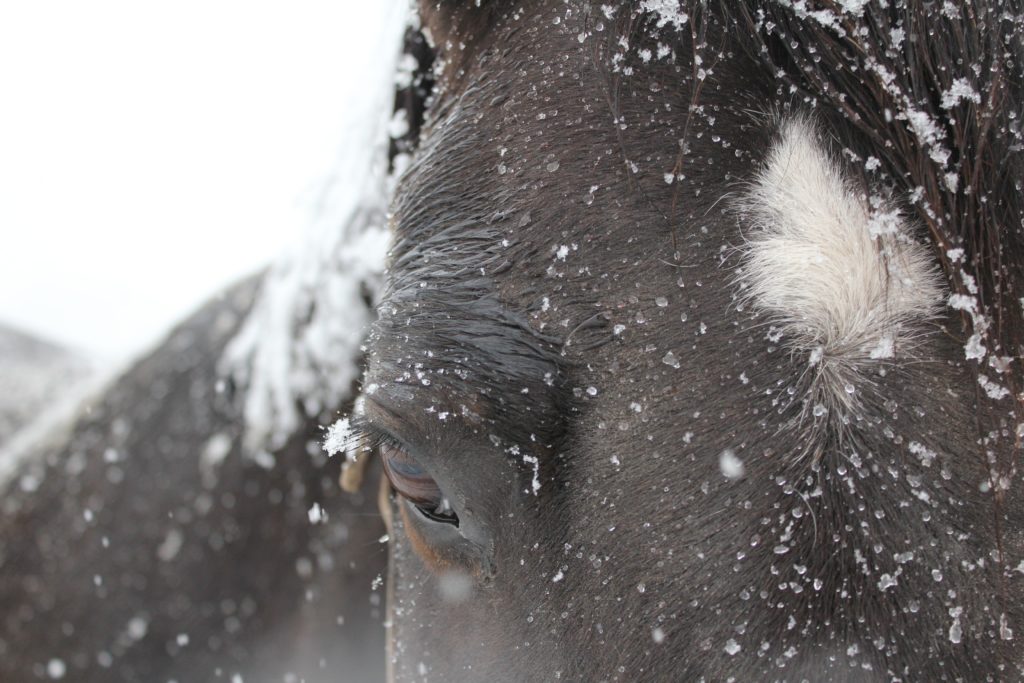
Like humans, age-related issues can affect horses’ eyes. While full blindness is rare, senior horses can develop senile cataracts and changes in the retina. Pigmentation changes, for example, at the back of the eye may affect the horse’s vision in low light.
Aging horses are commonly affected with equine recurrent uveitis (ERU). Also known as moon blindness, this disease is a leading cause of blindness in horses worldwide. It is generally considered to be an autoimmune condition characterized by recurrent inflammatory episodes in one or both eyes. Over time, this can lead to scarring, cataracts, pain and even blindness.
The good news is that horses tend to compensate well with changes in vision.
OCULAR HEALTH TIPS
- Watch for ocular changes: tearing, eye cloudiness, squinting, swelling of the lids, alterations in the colour of the cornea, spot or bluish tint on cornea, difficulty going from bright to dark areas, trouble negotiating obstacles, appearing tentative.
- Recognizing symptoms of eye issues early can result in more rapid diagnosis and treatment, helping to reduce the risk of permanent damage.
6. Loss of Fitness/Muscle Atrophy
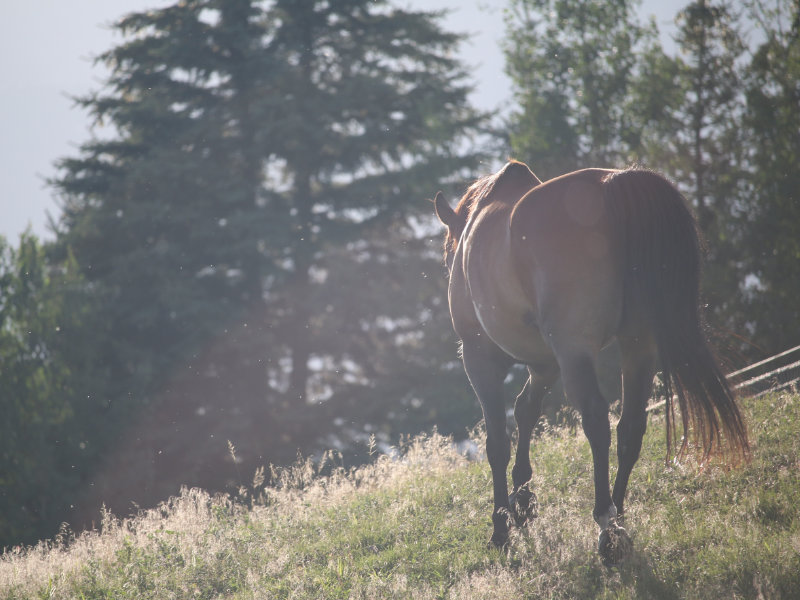
Inactivity is the main cause of loss of fitness and muscle mass in senior horses. Just like us, horses that keep exercising as they age stay stronger and sturdier than less-active equids. Unfortunately, once a senior horse loses its body conditioning, it can sometimes be difficult to restore because of physical limitations associated with old age. Often times, what is seen as a “kind retirement” can actually contribute to a loss of fitness due to decreased exercise.
A general loss of topline muscling (along spine) is not uncommon in senior horses. However, Lordosis, known as ‘swayback’, is the weakening of a horse’s supporting ligaments along the spine. It is the classic stereotype of an old horse. Age can be a contributing factor, but other contributing factors leading to swayback are: genetics, conformation, pregnancy, excessive strain on the back, metabolic diseases (i.e., PPID), arthritis in the vertebrae and decreasing exercise/fitness.
FITNESS TIPS
- Provide your horse with an opportunity for regular exercise for as long into the golden years as possible; if riding is no longer possible, hand-walking is an option.
- Ideally, keep your senior horse moving through 24-7 turnout with other companions versus standing still in a stall.


